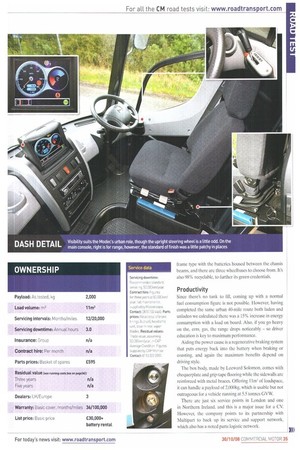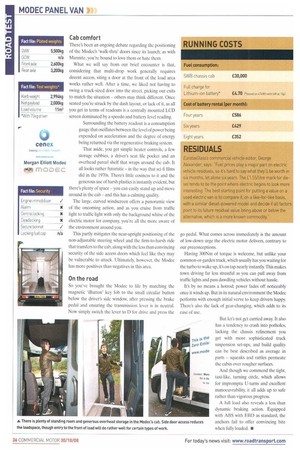Many of you out there might scoff at the notion
Page 34

Page 35

Page 36

If you've noticed an error in this article please click here to report it so we can fix it.
of buying an electric vehicle (EV) to join the rough and tumble of your road transport operation, citing unproven technology and lack of range as just a couple in a long line of hurdles standing in the way. And we'd agree, to a point.
However, just as a panel van can't do a tipper's job, electric vehicles are designed for a specific role making best use of their positives. And those positives are based around potentially lower fuel costs and, more significantly, no CO, emissions.
It's the latter factor that is proving most important in the leisurely yet deliberate take-up of these vehicles. as companies strive to prove their green credentials in the increasingly pro-environment landscape. But there's more, or rather, less: no congestion charge (where applicable), no road tax, no 0-licence and no (external) noise.
Coventry based Modec, which manufactures its 5.5-tonne GVW rigid truck in-house from the ground up, has seen its vehicles taken up by the likes of Tesco, Hi Idon Water and Speedyhire, which
Aare all keen to promote their progressive thinking to their customers and the world at large. Challenging the Modec you have Smith Electric, with its Avia D75-based 7.5-tonne Newton and its Ford Transit-based 5.5-tonne Edison. Unlike them, the Modec is purpose-designed and comes with two battery options that differ in terms of range and charge time. Our test vehicle is fitted with the newer lithium-ion option which offers a range of about 60 miles and a shorter charge time than the alternative 'zebra' sodium-nickel-chloride option, which has a range of 100 miles (and is soon to be phased).
Prices start at £30,000 for the chassis-cab, but unlike some EV manufacturers you rent the Modec's battery over a given period — the longer this is, the more economically viable it becomes. Chassis construction is of the ladder
frame type with the batteries housed between the chassis beams, and there are three wheelbases to choose from. It's also 98% recyclable, to further its green credentials.
Productivity
Since there's no tank to fill, coming up with a normal fuel consumption figure is not possible. However, having completed the same urban 40-mile route both laden and unladen we calculated there was a 15% increase in energy consumption with a load on board. Also, if you go heavy on the, erm, gas, the range drops noticeably — so driver education is key to maximum performance.
Aiding the power cause is a regenerative braking system that puts energy back into the battery when braking or coasting, and again the maximum benefits depend on driving style.
The box body, made by Leeward Solomon, comes with chequerplate and grip-tape flooring while the sidewalls are reinforced with metal braces. Offering 11m3 of loadspace, it can handle a payload of 2,000kg, which is usable but not outrageous for a vehicle running at 5.5 tonnes GVW,
There are just six service points in London and one in Northern Ireland, and this is a major issue for a CV. However, the company points to its partnership with Multipart to back up its service and support network, which also has a noted parts logistic network.
Cab comfort There's been an ongoing debate regarding the positioning of the Modec's 'walk-thru' doors since its launch: as with Marmite, you're bound to love them or hate them.
What we will say from our brief encounter is that, considering that multi-drop work generally requires decent access, siting a door at the front of the load area works rather well. After a time, we liked not having to swing a truck-sized door into the street, picking our exits to match the situation — others may think different. Once seated you're struck by the dash layout, or lack of it, as all you get in terms of readouts is a centrally mounted LCD screen dominated by a speedo and battery level reading.
Surrounding the battery readout is a consumption gauge that oscillates between the level of power being expended on acceleration and the degree of energy being returned via the regenerative braking system.
That aside, you get simple heater controls, a few storage cubbies, a driver's seat file pocket and an overhead parcel shelf that wraps around the cab. It all looks rather futuristic — in the way that sci-fi films did in the 1970s. There's little cosiness to it and the generous use of harsh plastics is instantly evident, but there's plenty of space — you can easily stand up and move around in the cab — and this has a calming quality.
The large, curved windscreen offers a panoramic view of the oncoming action, and as you cruise from traffic light to traffic light with only the background whine of the electric motor for company, you're all the more aware of the environment around you.
This partly mitigates the near-upright positioning of the non-adjustable steering wheel and the firm-to-harsh ride that transfers to the cab, along with the less than convincing security of the side access doors which feel like they may be vulnerable to attack. Ultimately, however, the Modec has more positives than negatives in this area.
On the road
So you've brought the Modec to life by matching the magnetic `iButton' key fob to the small circular button below the driver's side window, after pressing the brake pedal and ensuring the transmission lever is in neutral. Now simply switch the lever to D for drive and press the go pedal. What comes across immediately is the amount of low-down urge the electric motor delivers, contrary to our preconceptions.
Having 300Nm of torque is welcome, but unlike your common-or-garden truck, which usually has you waiting for the turbo to wake up, it's on tap nearly instantly. This makes town driving far less stressful as you can pull away from traffic lights and pass dawdling vehicles without hassle.
It's by no means a hotrod; power fades off noticeably once it winds up. But in its natural environment the Modec performs with enough initial verve to keep drivers happy. There's also the lack of gear-changing, which adds to its ease of use.
But let's not get carried away. It also has a tendency to crash into potholes, lacking the chassis refinement you get with more sophisticated truck suspension set-ups, and build quality can be best described as average in parts — squeaks and rattles permeate the cabin over rougher surfaces.
And though we commend the tight, taxi-like, turning circle, which allows for impromptu U-turns and excellent manoeuvrability, it all adds up to safe rather than vigorous progress.
A full load also reveals a less than dynamic braking action. Equipped with ABS with EBD as standard, the anchors fail to offer convincing bite when fully loaded. •




































































































































































